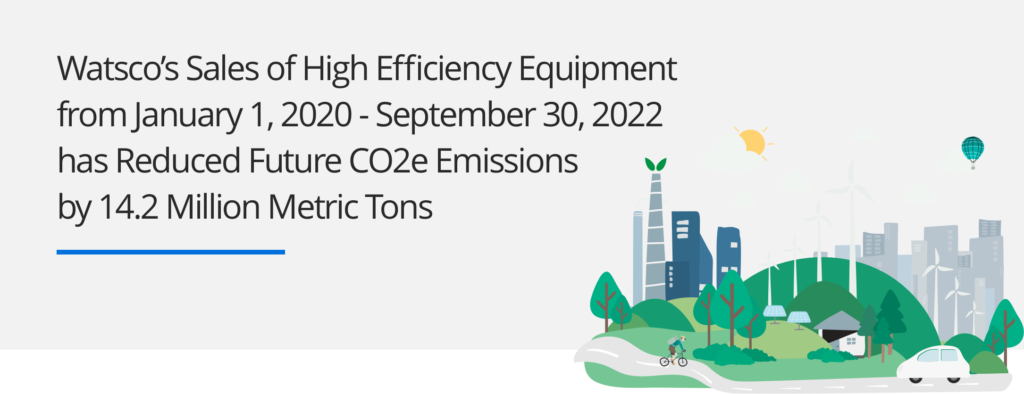Our Business is a Major Catalyst for CO2e Reduction

Watsco’s business plays an important and significant role in the drive to lower CO2e emissions. According to the Department of Energy, in the United States, half of a household’s annual energy consumption is for heating and air conditioning.* As such, in most cases, the most meaningful measure homeowners can take to reduce their carbon footprint and therefore their contribution to climate change is to increase the efficiency of their HVAC systems.
Every time Watsco sells an HVAC system to a contractor to replace an older system installed at a home or building, it results in a reduction in the amount of CO2e that is released into the atmosphere. This is especially true because older systems are likely operating below current government-mandated energy efficiency and environmental standards. New, high-efficiency heating and cooling systems operate more efficiently, so every time a new, high-efficiency system is installed, the homeowner will use less electricity or gas, which will emit less CO2e and save them money.
The seasonal energy efficiency rating, or SEER, is the metric used to measure the energy efficiency of AC systems. The higher the SEER, the more efficient the AC equipment. The current minimum SEER allowed for AC equipment is 13 SEER in the Northern U.S. and 14 SEER for much of the Southern U.S. Beginning in 2023, the minimum efficiency level for smaller residential HVAC systems under 45,000 BTUs will increase to 14 SEER in the North and 15 SEER in the South. For larger systems over 45,000 BTUs, the minimum efficiency level will be 14 SEER in the North and 14.5 SEER in the South. Heat pump efficiency levels will be raised to 8.8 HSPF for all three regions.
Here is an example to help understand the savings generated from replacing an older AC system with a new, high-efficiency system:
A single-family home in Florida has a 10-year-old, 3-ton system with a 10 SEER rating. Florida is the Sunshine State and the strong heat often causes the home to run the air conditioner for 3,000 hours per year on average. That system will therefore require 10.8 MwH of electricity per year to run. The Florida power grid emits 877 lbs. of CO2e on average for every MwH consumed. So, this household’s air conditioning system is responsible for emitting 9,472 lbs. of CO2e per year into the atmosphere. This is as much carbon dioxide emissions as those released by an average passenger vehicle driving 40,000 miles.
If this household upgrades to a 16 SEER system, it will require 38% less energy to run during those 3,000 hours, which would represent a reduction of 3,552 lbs. of CO2e emissions annually! Assuming this unit lasts 18 years, that is a total of almost 64,000 lbs. of CO2e emissions avoided over the lifetime of the new system.
A similar calculation can be made for the efficiency of heat pumps in heating mode and for gas-powered furnaces. The heating efficiency of heat pumps is expressed in HSPF (Heat Seasonal Performance Factor), while the heating efficiency of furnaces is expressed in AFUE (Annual Fuel Utilization Efficiency).
By applying this calculation to all cooling and heating systems sold by Watsco annually, the result is billions of pounds of CO2e emissions avoided (along with many dollars saved in electricity and gas costs).
Watsco is committed to accelerating the reduction of CO2e emissions by creating awareness and training, and investing in technology to support HVAC contractors in the sale, installation, and servicing of higher-efficiency replacement systems and related parts and supplies.
The metric featured on this page represents the total aggregated estimated tons of CO2e emission reduction from sales of high efficiency Watsco air conditioning and heating equipment in the U.S from January 1, 2020 through September 30, 2022. This metric is updated regularly.*
“Watsco’s methodology for calculating CO2e emissions savings from the sales of energy-efficient HVAC systems is sound and consistent with the way Carrier reports this metric. Watsco is a significant player in driving the reduction in CO2e emissions in our industry.”
–Richard Lord, senior fellow at Carrier Global and fellow at ASHRAE.
Data Sources and Assumptions Supporting our Estimates:
- Estimated aggregate metric tons of carbon dioxide equivalents (CO2e) reduced from Watsco’s sale of high-efficiency residential air conditioning and heating equipment since January 1, 2020.
- Based on Watsco sales data for residential air conditioning systems and furnaces since January 1, 2020.
- The metric only includes the installation of high-efficiency systems and does not consider CO2e emission-reduction from the sale of minimum-required efficiency systems.
- CO2e savings are calculated as the incremental benefit between the emissions of the high efficiency systems sold and the equivalent emissions had the sale been a minimum efficiency system.
- Emissions savings are calculated for the total lifetime of the system sold and accounted for in the year it was sold. The model uses 18 years as the average lifetime of an AC system and furnace, and assumes indoor and outdoor units are matched to maintain maximum efficiency.
- Includes primarily the replacement market and excludes systems sold to the new housing market.
- Annual cooling hours per state sourced from 2002 EPA data.
- CO2e emissions per KwH sourced from 2019 egrid data (epa.gov).
- CO2e emissions and BTU per cubic ton of natural gas sourced from the Energy Information Administration (eia.gov).
- CO2e is a metric that quantifies GHG emissions based on their equivalent in CO2e. Examples of other GHGs emitted during the generation of electricity are methane (CH4), Nitrous Oxide (N2O), and Sulfur Dioxide (SO2).
- Energy equivalent calculator on epa.gov.
- Household energy consumption from heating and cooling data sourced from energystar.gov